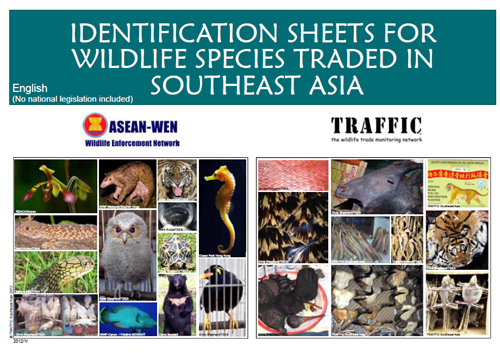Asian initiative helps tackle challenge of species identification
Hyderabad, India, 16th October 2012—“If they could recognize half the animals we carry, we’ll be in real trouble”. These words, uttered by “Kenny”, a Malaysian wildlife trafficker, sum up one of the challenges to Southeast Asia’s efforts to prevent loss of biodiversity via illegal wildlife trade.
 The Global Taxonomy Initiative (GTI) of the Convention on Biological Diversity (CBD) and its related Capacity-building Strategy, as agreed here at its 11th meeting of the Conference of the Parties (CoP11), sets out to address how taxonomy can support the sound management of biodiversity by providing relevant information. CBD CoP11 has invited Parties and other governments to support the GTI’s Capacity-building Strategy. The East and Southeast Asian Biodiversity Information Initiative (ESABII), set up by 14 countries in the region in partnership with relevant organizations, works to achieve the goals of the CBD.
The Global Taxonomy Initiative (GTI) of the Convention on Biological Diversity (CBD) and its related Capacity-building Strategy, as agreed here at its 11th meeting of the Conference of the Parties (CoP11), sets out to address how taxonomy can support the sound management of biodiversity by providing relevant information. CBD CoP11 has invited Parties and other governments to support the GTI’s Capacity-building Strategy. The East and Southeast Asian Biodiversity Information Initiative (ESABII), set up by 14 countries in the region in partnership with relevant organizations, works to achieve the goals of the CBD.
In support, TRAFFIC in Southeast Asia has produced a set of simple identification sheets designed to provide assistance. These user-friendly sheets are available in all eight of Southeast Asia’s national languages and in Chinese and Japanese. They have proved to be an invaluable tool to help frontline officers determine whether a species is being traded legally or not.
“Collaboration with the Ministry of the Environment of Japan as part of its engagement with ESABII has allowed additional species to be included within the identification sheets, and also enabled their production in Chinese and Japanese”, said Claire Beastall, TRAFFIC’s Training and Capacity Building Co-ordinator in Southeast Asia, who led in the sheets’ production.
Claire Beastall of TRAFFIC showcasing an ESABII ‘Training of Trainers’ course held in Viet NamThe achievements and future plans of ESABII were highlighted today at a side event at CoP11, currently under way in Hyderabad, India. This event was organized by the ESABII Secretariat, the Ministry of the Environment of Japan.
TRAFFIC’s identification sheets in local languages have been made available to enforcement agencies across East and Southeast Asia and used during training conducted for many hundreds of wildlife enforcement officers across the region since their launch in 2009. This newest set contains some 90 identification sheets.
The latest English version of the sheets is being made available for the first time on the TRAFFIC and Association of Southeast Asian Nations—Wildlife Enforcement Network (ASEAN-WEN) websites.
Additional translated country versions for Brunei Darussalam, Cambodia, China, Lao PDR, Indonesia, Japan, Malaysia, Myanmar, Philippines, Singapore, Thailand and Viet Nam will be made available over the coming weeks.
The sheets show clear identification features of the species concerned, and give information on look-alike species, relevant legislation and the form in which each species is commonly traded.
“This latest development and the Ministry of the Environment of Japan’s continued engagement through ESABII to support ASEAN-WEN will increase capacity and awareness among law enforcement officers. Such support will help fight the illegal wildlife trade that threatens the region’s biodiversity”, said Manop Lauprasert, Senior Officer of the ASEAN-WEN Program Coordination Unit.
TRAFFIC would like to acknowledge the support of the Ministry of the Environment, Japan, and other partners who have made the production of these resources possible.



